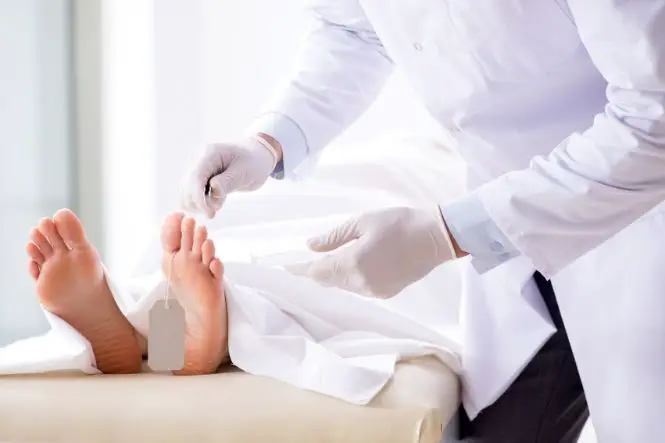An external examination of a corpse is essential at two stages in the forensic science process.
The first time an external examination is carried out is upon discovery of a corpse. At this point the body should be checked for visible signs of injury and those injuries that are most likely to have caused subsequent death.
At this stage both the Pathologist and Scenes of Crime Officer (SOCO) are present as well as authorised police personnel and the body is checked over in what is known as a preliminary examination.
Whilst the Scenes of Crime Officer (SOCO) is taking photographs of the corpse and surrounding area – and in particular photographing wounds and injuries pointed out to him or her by the pathologist – the pathologist will examine these wounds and measure them.
Clothing will also be examined for any signs of excreted bodily fluids and/or fibres.
Once the body has been removed from the scene of crime and taken for pathological examination there is another external examination to be carried out before an autopsy can be completed.
This examination is conducted to determine height and weight and also to facilitate the photographing of the corpse in its post mortem state. This is also done to ensure that no additional post mortem injuries have been sustained.
The clothes of the deceased are thoroughly checked for fibres, hairs, bodily fluids and blood stains; as well as for tears and rips that might correspond to knife or gun attacks.
The body is then checked for signs of rigor mortis (stiffening of the muscles post mortem) and lividity (settling of the blood post mortem); both of these conditions can be measured and used as a means of determining time of death. In addition to this these conditions can also be used to help determine whether or not a body has been moved post mortem prior to its discovery.
Sometimes x-rays are taken at the external examination stage if there are visible head injuries.
What Happens During The Examination?
During this external examination fingernails are clipped or scraped clean so that any material underneath may be examined for traces of skin or blood possibly that of an attacker. Pubic hair is combed for traces of skin and the area around the sexual organs – particularly in sexually related murders – is swabbed.
Injuries such as cuts and bruises are marked out and in cases of stabbings or shootings the entrance wounds are measured in order to gauge closeness of the victim to the perpetrator and also to try and establish what kind of knife or gun was used in the attack.
Throughout the process the pathologist will make audio notes as to his or her discoveries and his assistant will take photographs and make written notes on a detailed sketch of the body so that a detailed autopsy report can be produced once the autopsy proper has been carried out.
At all times throughout the process notes are taken so that there can be nothing left to chance from a medical point of view.

